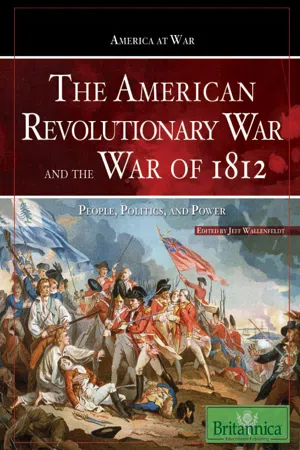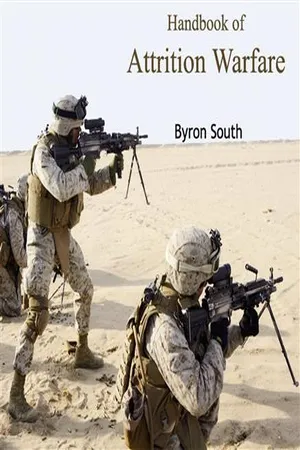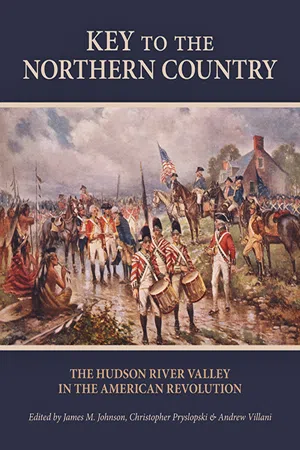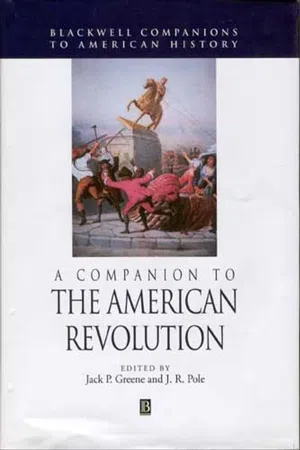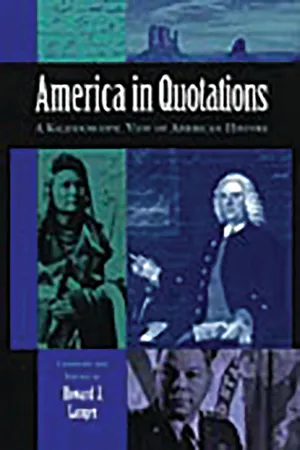History
Battles of the American Revolution
The Battles of the American Revolution were a series of military engagements fought between the American colonies and Great Britain from 1775 to 1783. Key battles included Lexington and Concord, Bunker Hill, Saratoga, and Yorktown. These battles were pivotal in shaping the outcome of the war and ultimately led to the independence of the United States from British rule.
Written by Perlego with AI-assistance
Related key terms
1 of 5
7 Key excerpts on "Battles of the American Revolution"
- eBook - PDF
The Revolutionary Era
Primary Documents on Events from 1776 to 1800
- Carol Sue Humphrey(Author)
- 2003(Publication Date)
- Greenwood(Publisher)
C H A P T E R 3 The Battles of the Revolutionary War, 1776-1781 T he fighting in the American Revolution lasted from April 19,1775, to October 19, 1781. During these six-plus years, both sides won some battles and lost some battles. The British concentrated their efforts on conquering population centers because that was how wars were won in Europe—you took control of the major city or cities and the country surrendered. But that did not work in the American colonies. At one time or another, the British occupied every major American city (including New York from September 15,1776, to No- vember 25,1783), and still the war went on. The colonials, under the leadership of George Washington, just tried to survive. While trying to win military engagements, Washington realized that the most important goal was for the Continental army to continue to func- tion. As long as the army existed the war would go on. Washington tried to reduce major losses in men and supplies by avoiding major battles. Only when the circumstances were almost perfect at Yorktown, with Cornwallis holed up on a peninsula and the French fleet threatening to defeat the British navy, did Washington commit the bulk of his forces to a single battle. Throughout the conflict, the newspapers worked to keep their readers informed and to put the best face on the results of various military engage- ments. Thus, the paper's side—be it Patriot or Loyalist—always came out on top, no matter what the actual outcome had been. The documents below are divided into five sections by the battles that are discussed: Trenton, Germantown, Saratoga, Camden, and Yorktown. In each section, both Patriot and Loyalist views of what happened at the battle are included. And, in each case, the winners emphasize the glories of victory while the losers downplay or almost ignore the losses of defeat. 49 50 The Revolutionary Era Trenton The battle that occurred at Trenton on December 25, 1776, was really more of a skirmish than a battle. - eBook - ePub
The American Revolutionary War and The War of 1812
People, Politics, and Power
- Britannica Educational Publishing, Jeff Wallenfeldt(Authors)
- 2009(Publication Date)
- Britannica Educational Publishing(Publisher)
HE BATTLES OF THE AMERICAN REVOLUTIONA t first, it seemed inevitable that the British would put a quick end to the colonists’ rebellion that had begun in Lexington and Concord on April 19, 1775. After all, the British Empire had arguably the best-trained army and mightiest navy in the world, while the American troops were poorly paid, undisciplined, and led by inexperienced generals. Indeed, Gen. George Washington made a number of serious strategic blunders in the early days of the war.Yet, the Americans had their own advantages. They knew their vast, complex terrain and capitalized on that familiarity by using guerrilla tactics. Unlike the British, the Americans were not dependent on the transatlantic shipment of men and materiel, and could fight a defensive war. Even if the British won battles and had Loyalist support, they could not win over the great majority of the people. As war destroyed lives and property in the colonies, opinion hardened against the British. Furthermore, as the fighting dragged on, opinion against the war hardened in Britain as well. Although Britain triumphed in many individual battles, this mighty, war-tested country ultimately lost the war.BATTLES OF LEXINGTON AND CONCORD
Acting on orders from London to suppress the rebellious colonists, Gen. Thomas Gage, recently appointed royal governor of Massachusetts, ordered his troops to seize the colonists’ military stores at Concord. En route from Boston, on April 19, 1775, the British force of 700 men was met on Lexington Green by 77 local Minutemen and others who had been forewarned of the raid by the colonists’ efficient lines of communication, including the ride of Paul Revere. It is unclear who fired the first shot. Resistance melted away at Lexington, and the British moved on to Concord. Most of the American military supplies had been hidden or destroyed before the British troops arrived. A British covering party at Concord’s North Bridge was finally confronted by 320 to 400 American patriots and forced to withdraw. The march back to Boston was a genuine ordeal for the British, with Americans continually firing on them from behind roadside houses, barns, trees, and stone walls. This experience established guerrilla warfare as the colonists’ best defense strategy against the British. Total losses were British 273, American 95. The Battles of Lexington and Concord confirmed the alienation between the majority of colonists and the mother country, and it roused some 15,000 New Englanders to join forces and begin the Siege of Boston, resulting in its evacuation by the British the following March. - eBook - PDF
- P. Scott Corbett, Volker Janssen, John M. Lund, Todd Pfannestiel, Paul Vickery, Sylvie Waskiewicz(Authors)
- 2014(Publication Date)
- Openstax(Publisher)
The American victory at the Battle of Saratoga was the major turning point in the war. This victory convinced the French to recognize American independence and form a military alliance with the new nation, which changed the course of the war by opening the door to badly needed military support from France. Still smarting from their defeat by Britain in the Seven Years’ War, the French supplied the United States with gunpowder and money, as well as soldiers and naval forces that proved decisive in the defeat of Great Britain. The French also contributed military leaders, including the Marquis de Lafayette, who arrived in America in 1777 as a volunteer and served as Washington’s aide-de-camp. The war quickly became more difficult for the British, who had to fight the rebels in North America as well as the French in the Caribbean. Following France’s lead, Spain joined the war against Great Britain in 1779, though it did not recognize American independence until 1783. The Dutch Republic also began to support the American revolutionaries and signed a treaty of commerce with the United States in 1782. Great Britain’s effort to isolate New England in 1777 failed. In June 1778, the occupying British force in Philadelphia evacuated and returned to New York City in order to better defend that city, and the British then turned their attention to the southern colonies. 6.3 War in the South By the end of this section, you will be able to: • Outline the British southern strategy and its results • Describe key American victories and the end of the war • Identify the main terms of the Treaty of Paris (1783) By 1778, the war had turned into a stalemate. Although some in Britain, including Prime Minister Lord North, wanted peace, King George III demanded that the colonies be brought to obedience. To break 168 Chapter 6 | America's War for Independence, 1775-1783 This OpenStax book is available for free at https://cnx.org/content/col11740/1.3 - No longer available |Learn more
- (Author)
- 2014(Publication Date)
- University Publications(Publisher)
________________________ WORLD TECHNOLOGIES ________________________ Chapter- 5 American Revolutionary War The American Revolutionary War (1775 – 1783) or American War of Independence began as a war between the Kingdom of Great Britain and thirteen British colonies in North America, and concluded in a global war between several European great powers. The war was the culmination of the political American Revolution, whereby many of the colonists rejected the legitimacy of the Parliament of Great Britain to govern them without representation, claiming that this violated the Rights of Englishmen. The First Continental Congress met in 1774 to coordinate relations with Great Britain and the by-then thirteen self-governing and individual provinces, petitioning George III of Great Britain for intervention with Parliament, organizing a boycott of British goods, while affirming loyalty to the British Crown. Their pleas ignored, and with British soldiers billeted in Boston, Massachusetts, by 1775 the Provincial Congresses formed the Second Continental Congress and authorized a Continental Army. Additional petitions to the king to intervene with Parliament resulted in the following year with Congress being declared traitors and the states to be in rebellion. The Americans responded in 1776 by formally declaring their independence as one new nation — the United States of America — claiming their own sovereignty and rejecting any allegiance to the British monarchy. France's government under King Louis XVI secretly p rovided supplies, ammunition and weapons to the revolutionaries starting in 1776, and the Continentals' capture of a British army in 1777 led France to openly enter the war in early 1778, which evened the military strength with Britain. - eBook - ePub
Key to the Northern Country
The Hudson River Valley in the American Revolution
- James M. Johnson, Christopher Pryslopski, Andrew Villani, James M. Johnson, Christopher Pryslopski, Andrew Villani(Authors)
- 2013(Publication Date)
- SUNY Press(Publisher)
Just thirty miles north of the valley, another important event occurred: the American victory at Saratoga in 1777. When asked to provide a specific event or date in the American Revolution where the specter of victory shifted from the British to the colonists, many scholars cite the Battle of Saratoga. Colonial military historian Richard Ketchum credits British General John Burgoyne's surrender on October 17, 1777, as essential for convincing the French government to ally with the Americans. In Ketchum's view, without Saratoga “there is no telling what might have happened,” since the absence of the alliance may have led the Americans to sue for peace due to the sustained economic strain of two years of conflict and the deterioration of their fighting forces. 1 For the Hudson River Valley, this decisive battle also denied the British control of the river that they had hoped to secure in order to split rabblerousing New England from the crops and manpower of the Middle and Southern colonies. While the importance of Saratoga is not disputed, some historians contend that Burgoyne's surrender is directly traceable to the Battle of Valcour Island, which delayed an earlier British attack in the fall of 1776, thereby providing the Americans with an additional year to prepare their defenses for the British northern invasion of New York. 2 This unique naval battle fought on Lake Champlain, seventy miles north of Saratoga Springs, should be considered the opening phase of the Saratoga campaign, making it a relatively obscure engagement that deserves greater attention by students of the American struggle for independence. Studies of naval operations during the Revolution commonly focus on European sea battles in the West Indies, Captain John Paul Jones' exploits in British waters, Admiral François Joseph Paul de Grasse's success in the 1781 Battle of the Chesapeake, or the transatlantic logistics responsible for sustaining the Continental Army - eBook - PDF
- Jack P. Greene, J. R. Pole, Jack P. Greene, J. R. Pole(Authors)
- 2008(Publication Date)
- Wiley-Blackwell(Publisher)
——: Roots of Conflict: British Armed Forces and Colonial Americans, 1677–1763 (Chapel Hill: University of North Carolina Press, 1986). Shy, J.: Toward Lexington: the Role of the British Army in the Coming of the American Revolution (Princeton, NJ: Princeton University Press, 1965). I N the West, constant conflict and change marked the 20 years preceding Indepen-dence. Though the elimination of the French empire in North America and the acquisi-tion of Spanish colonies had demonstrated beyond doubt a British ascendancy, the victor’s inability to establish effective control over an immense expanse, where Amerindians, settlers, speculators, colonial governors and imperial officials were continually in con-flict, was even more clearly evident. During these years expansion to the west made a significant contribution not to the profits but to the bankruptcy of an imperial policy so recently marked by military humilia-tion during the Seven Years’ War and the Rebellion of Pontiac, followed by failure to organize the regulation of Amerindian affairs, and incapacity in Westminster and Whitehall to manage Western settlement and establish new colonies. Victory in war had therefore only magnified the problems of the ensuing peace. Frontier traders, settlers, and speculators regarded the British declaration of war on France in May 1756 as an event of no great significance: Washington’s surrender at Fort Necessity in July 1754, the expulsion of the Acadians from Nova Scotia, and Braddock’s defeat and death on the Monongahela in the following year made a far greater impression. The converse did not hold good: the conflict in America drew the attention of Europeans to the particular prospects and distinguishing features of New World societies. - eBook - PDF
America in Quotations
A Kaleidoscopic View of American History
- Howard J. Langer(Author)
- 2002(Publication Date)
- Greenwood(Publisher)
4 The American Revolution It was the first colonial war in the history of the world. Officially, it began in 1775 at Lexington, Massachusetts, but its origins began much earlier—in the mid-1760s with what colonists regarded as un- fair taxes. The first deaths of the war came in 1770, with the so- called Boston Massacre. Whenever the war began, it ended with British recognition of the infant United States of America and set an example for Europeans, Asians, Latin Americans, and Africans in the centuries to come. POLITICAL SLOGAN 57. Taxation without representation is tyranny! (Slogan, early 1770s.) MASSACRE—OR SELF-DEFENSE? On March 5, 1770, five Bostonians were killed and six wounded when British troops fired on what they thought was a threatening mob. The incident would become known in American history as the 28 AMERICA IN QUOTATIONS "Boston Massacre." Months later, a murder trial was held. The fol- lowing are excerpts from the concluding arguments of both sides. 58. If an assault was made to endanger their lives, the law is clear they [the British soldiers] had a right to kill in their own defense. If it was not so severe as to endanger their lives, yet if they were assaulted at all, struck and abused by blows of any sort, by snowballs, oyster shells, cinders, the law reduces the offense of killing down to manslaughter, in consideration of those passions of our nature which cannot be eradicated. (John Adams, defense attorney, address to the jury, Boston, December 7, 1770, cited in The Case for Courage, by William M. Kun- stler.) 59. [The evening of the violence] a number of soldiers had come out of their barracks, armed with clubs, bayonets, cutlasses and instruments of diverse kinds, and in the most outrageous manner were ravaging the streets, assaulting everyone they met.
Index pages curate the most relevant extracts from our library of academic textbooks. They’ve been created using an in-house natural language model (NLM), each adding context and meaning to key research topics.

